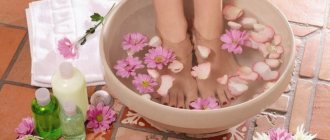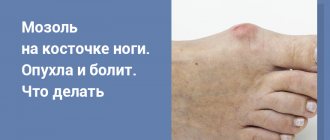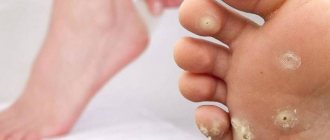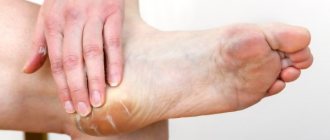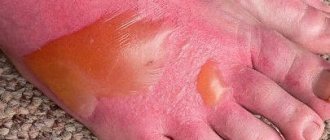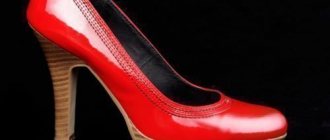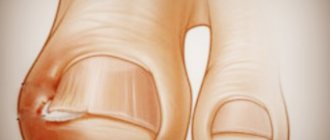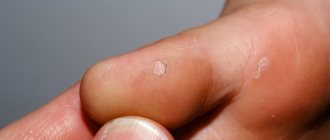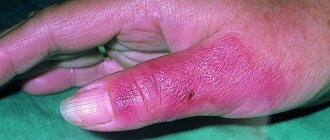What to apply to a burst callus for quick healing?
A water callus is a skin formation that is a bubble of fluid that appears as a result of mechanical friction . It may be caused by tight shoes. Calluses form on the palms and fingers due to prolonged friction, for example, when working with any tool. The blister cannot be punctured or cut off , as this can lead to the development of a purulent infection and longer treatment. And in cases where the callus bursts on its own, it requires immediate treatment and taking the necessary measures to prevent further complications.
Calluses - functions and types
The formation of calluses is a way of protecting the skin from the penetration of pathogens into its deeper layers. Temporary growths appear where the skin is subjected to strong and prolonged mechanical impact. Most often, calluses form on the feet and hands.
In medicine, calluses are divided into two types - wet and dry. Wet ones are also called water ones, and if the situation has gone too far - bloody. Dry calluses are also divided into simply dry and core ones. In the latter case, callus formations develop until a growth is formed that goes deep into the skin.
Dry calluses are formed during prolonged, but mild, mechanical exposure. Wet calluses are a reaction of sensitive skin to intense friction. As a result, the epidermis loses connection with the dermis, that is, a traumatic detachment of the upper layer from the lower one is formed, and intercellular fluid is poured into the resulting space.
This is how the same bubble with liquid inside is formed. If pressure continues to be applied to it, the lower layers of skin are exposed, and their tissues are injured and damaged to the point of bleeding.
READ MORE: Callus formation during a spinal fracture
First aid for a burst callus
Squeezing the resulting bubble, prolonged friction, or impact can cause it to rupture. If a callus bursts, it is necessary to take action immediately. Rupture of the film and its tearing off is an open path for staphylococcal and streptococcal infections.
Actions to take if fluid begins to ooze from the blister:
- Wash your hands using soap or wipe with a bactericidal wet wipe.
- Prepare any antiseptic (furacilin, alcohol-containing product, hydrogen peroxide or make a weak solution of manganese), bandage or plaster, antimicrobial ointment .
- Treat the wound and the area around it with an antiseptic.
- If the liquid flowing from the bladder is clear and does not contain blood, the callus can be filled with medical glue or covered with a bactericidal plaster . This wound heals in 2–3 days.
- When the callus is large and open (the skin is torn or shifted), after treatment it is necessary to apply a gauze pad with antimicrobial ointment and secure it either with a bandage or bandage it . The dressing is changed every 3 to 4 hours.
Note! You cannot treat a burst callus with iodine or brilliant green. These products may cause burns. Iodine and brilliant green have a drying effect; their use will cause the delicate skin in the callus area to begin to crack.
What to do if a callus bursts
Many people leave the wound at the site of a burst callus without attention, believing that it will heal on its own. In fact, this is not the right thing to do, since an untreated wound is a “fertile” environment for the growth of bacteria.
Algorithm of actions to prevent infection:
If the callus is “fresh” and has just burst, the wound should be blotted with a sterile bandage to remove all the liquid. It is better not to use dry cotton swabs, as small hairs from the cotton wool may remain on the surface.- Then treat the surface with an antiseptic, for example, hydrogen peroxide, and apply a bandage or plaster for wet calluses. The wound should be covered if you need to wear socks or shoes. At home, it is better to let the wound dry a little after treatment. This way it will heal faster and heal faster. Leave the surface of the skin open overnight.
- Sometimes the surface needs to be anointed with bactericidal ointments, but it is better to do this if there is a risk of inflammation.
The faster the wound dries, the sooner it will heal. Do not lubricate the wound with moisturizers, wash with nourishing shower products, or use patches for dry calluses. The patch must be either bactericidal or intended for wet calluses.
It is not always possible to maintain the integrity of a wet callus. Often the film breaks on its own and the liquid flows out.
In this case, the main thing is to carry out disinfection in time, since an open, weeping wound is an excellent breeding ground for staphylococcal or streptococcal infections.
Iodine, furatsilin solution, potassium permanganate, brilliant green, 70% alcohol, 2% hydrogen peroxide are suitable for the procedure.
The procedure is performed with thoroughly washed hands. The treated area also needs to be cleaned of dirt.
It is necessary to lubricate the damaged area so that the product does not get directly into the wound, as this will slow down tissue healing.
A bactericidal or anti-callus patch is glued to the treated area. It protects the wound from bacteria and absorbs remaining lymphatic fluid.
If you follow another method, you need to lubricate the callus with salicylic ointment or pine resin and apply a sterile bandage.
Is it possible to pierce
If a wet callus is large in size and located in a place that is subject to mechanical stress, it causes serious inconvenience.
In this case, it can be pierced, but you must follow several rules:
- Hands must be washed thoroughly with soap; you can additionally use antibacterial gel.
- The puncture is made with a disinfected needle. To disinfect the instrument, it is calcined over a fire or washed in alcohol. Disinfection should take place within a few minutes.
- The area of damage is also disinfected by wiping with an alcohol solution, iodine or brilliant green.
- The puncture is carefully made, holding the needle almost parallel to the skin. It is important not to touch the bottom of the callus with the tool, as this will lead to serious inflammation.
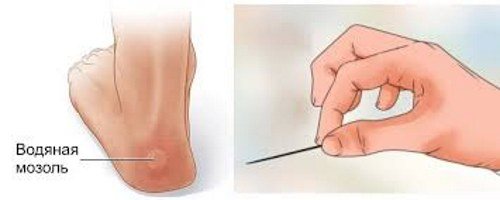
- To enhance the outflow of liquid, you need to make several punctures, but so that the skin does not break completely. The surface must be relatively intact so that it can protect the delicate skin from infection.
- Then a sterile napkin is applied to the callus and the callus is pressed. The liquid will leak out and the top skin will stick to the bottom of the callus.
- Antibiotic ointment is applied to the wound, then the damaged area is covered with a band-aid. The patch must be changed 2 times a day and removed at night. When exposed to air, the callus will dry out faster.
In the absence of proper treatment at home, a broken callus on the foot can easily become infected, since the loose, delicate skin located under the upper film of a wet callus is a suitable environment for the spread of infection. However, the infection penetrates not only into an open wound, but also into a closed one.
General signs of infection are as follows:
- Nearby tissues become inflamed and red.
- The damaged area is very painful.
- Lymphatic fluid becomes cloudy.
- Purulent contents are released.
- The callus area becomes covered with yellow crusts.
- Body temperature rises.
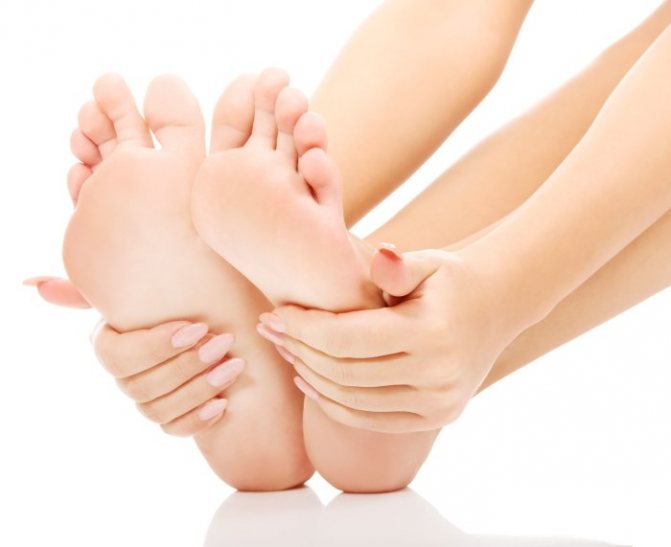
It is necessary to open the callus on the foot, if infection does occur, remove the skin covering the internal space, disinfect it, apply antibacterial ointment, and cover with a sterile bandage. Treatment at home is not continued if the condition worsens, but consult a doctor, since in such cases drug treatment is required.
Don't miss the most popular article in the section:
Morning exercises for those over 40, 50. Gymnastics exercises for weight loss, video lessons.
Remedies for rapid healing of calluses
To ensure that the wound heals quickly, you can cover it with a bactericidal patch for wet calluses or apply an antimicrobial ointment.
If the above remedies are not available, you can treat the wound with what is at hand, i.e. folk remedies.
Healing patches
It is impossible to seal wet calluses, and especially burst ones, with a plaster intended for corns, ingrown or dry calluses.
Adhesive plasters made of hydrocolloid material are intended for their treatment . They have a mild analgesic effect, a bactericidal effect and protect against moisture penetration .
For burst calluses, silicone adhesive plaster “ Compid ” is suitable, preventing moisture from entering with an analgesic effect.
Salicylic patch with a plastic membrane is impregnated with salicylic acid. The base of the product is 100% cotton, which allows the wound to breathe, while the membrane protects the callus from getting wet.
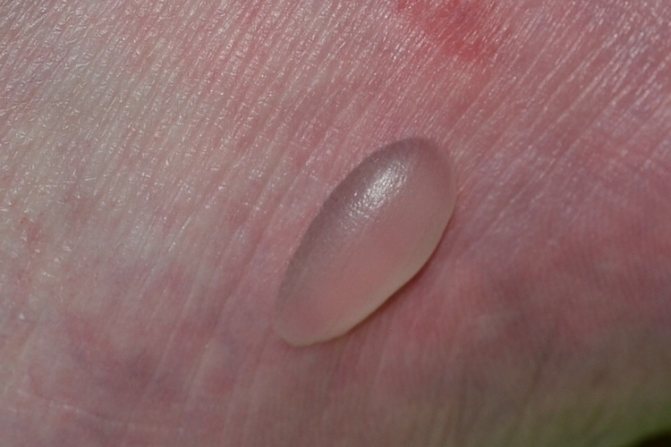
Photo 1. You should try to preserve the small bubble. If the callus has burst, you should use healing ointments. Source: Flickr (Dennis Verbeek).
Ointments for burst calluses
After treating a burst blister with an antiseptic, it is recommended to apply an antimicrobial and anti-inflammatory ointment.
Products such as Levomekol , Syntomycin and salicylic acid , Tetracyclic , Ichthyol , Heparin ointment , the “ Rescuer ” product, balsamic liniment ( Vishnevsky ), etc. have a good effect.
Levomekol
Inexpensive, but quite effective means of combined action. The antibiotic chloramphenicol contained in the product has a bacteriostatic effect.
Methyluracil promotes rapid regeneration .
Thanks to polyethylene oxides, pus is removed from the wound faster .
Levomekolev ointment helps to speed up the healing of purulent calluses.
Syntomycin ointment
Refers to antibiotic . The main active ingredient is chloramphenicol, which is effective in purulent-inflammatory processes. Apply the product to the wound every 5-8 hours. It is better not to use for children under 3 years of age and pregnant women.
Salicylic ointment
Recommended for the treatment of skin diseases. The active ingredient of the product is salicylic acid. This is an excellent antiseptic , it also has an anti-inflammatory effect , promotes rapid exfoliation and regeneration of the skin .
The ointment should be used with caution by pregnant women and children; do not use in large quantities or for a long time.

Photo 2. The first action when a callus is detected should be to stop rubbing. Source: Flickr (Panegyrics of Granovetter).
Folk remedies for treating burst calluses
When there are no pharmaceutical products, a burst callus can be treated with medicinal plants.
- The first aid is plantain leaf . Rinse it well and lightly rub it in your hands until the juice appears. Apply the sheet to the callus and secure with a bandage or plaster. The plantain should be changed every 3 hours.
- Aloe or Kalanchoe flower on hand , they can also be used as bactericidal and healing agents. It is necessary to squeeze the juice out of the leaf and apply a gauze pad soaked in this juice to the wound and fix it.
- Conifer resin will help if you soak a napkin in a heated mixture of resin and butter and apply it to the burst callus. In addition to its bactericidal effect, it is also a good pain reliever.
Fir oil, honey, celery juice will help speed up the healing of burst calluses .
Preventing the formation of calluses
What to do to avoid such an unpleasant and painful problem as a burst callus?
- First, wear comfortable shoes . Often, the foot gets chafed in new, unworn shoes. It is better to wear such products for a short time and have a replaceable pair. New shoes can be treated with special softening agents or sent for stretching. Sports shoes should be half a size larger, since active walking and exercise increases blood flow in the feet.
- Wearing the right socks also reduces friction.
- If there is a risk of calluses appearing on the palm, it is better to work with gloves or use special protective products.
- Baths, foot and hand cream, and antiperspirants for feet will help prevent the appearance of calluses.
- For comfortable wearing of shoes, you can use gel pads .
Note! If discomfort and redness occur, it is necessary to change shoes if possible. If this does not work, the area must be sealed with a plaster to eliminate the cause of the callus.
Reasons for appearance
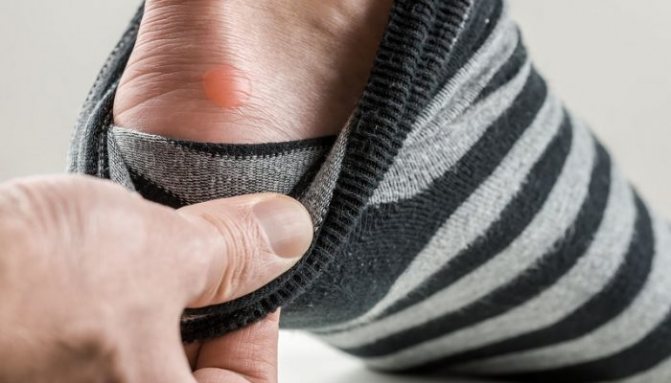
Calluses can appear for the following reasons:
- Wearing uncomfortable shoes. Shoes or boots with a hard heel will certainly cause the appearance of calluses near the heels, which will subsequently lead to roughening of the skin. If we are talking about high-heeled shoes, then chafing may appear on the plantar part of the foot (near the toes).
- Hyperhidrosis of the feet. Excessive sweating of the feet leads to constant exposure of the skin to a damp environment. Because of this, wet calluses are formed, which are prone to frequent ruptures.
- Flat feet. Provokes a strong uneven load on the entire foot.
- Large body weight.
- Prolonged work on your feet.
- Hyperthyroidism. Increased secretion of thyroid hormones, which leads to dry skin, making it more susceptible to calluses.
- Fungal infections. They corrode the skin of the feet, drying it out, as a result of which damage occurs much more often.
What to do for healing?
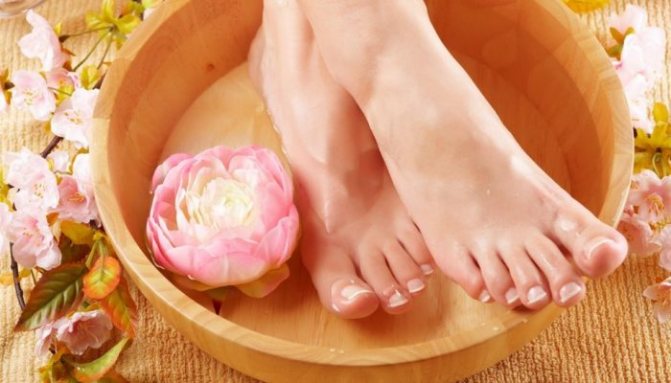
To get rid of calluses, it is necessary, first of all, to eliminate one or more causes of their appearance. You also need to consult a doctor, in the case of flat feet, even an orthopedist, in order to cure a pathology that cannot be eliminated on your own.
Let's look at the treatment methods for each type of callus separately.
Sukhikh
Dry calluses most often appear in the spaces between the toes, on the toes, heels, and the front of the sole. They are an excessively keratinized area of skin that often cracks and can become infected through the resulting lesions.
There are 2 main ways to treat dry calluses:
- Treat the formation with peroxide or any other antiseptic, lubricate it with a solution of brilliant green, and seal it with a bactericidal plaster on top.
- Treat the callus with calendula ointment and apply a patch.
You can also treat skin damage with potatoes. To do this, the root vegetable needs to be grated, applied to the callus, bandaged and covered with a bag on top. This procedure softens the top layer well.
The most important thing is to create as little stress as possible on the affected area.
Soft
Soft calluses usually form when there is concomitant hyperhidrosis of the feet or in very hot weather. They burst quite often and become infected in almost 100% of cases.
To prevent the development of a purulent process in a wound or to cure an existing one, it is necessary to use Baneocin powder. The method of its use is indicated in the official instructions for the drug.
Rodzhnev
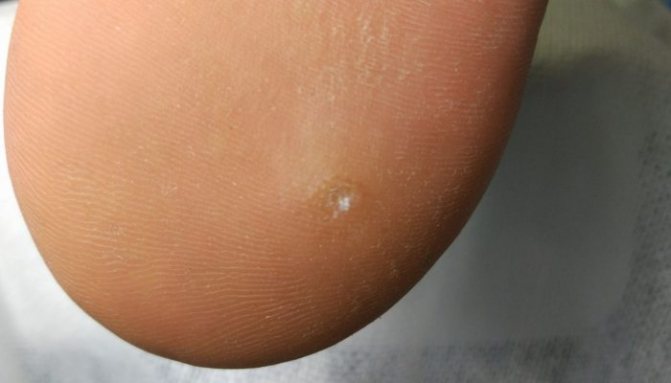
Core calluses look like very hard and dense formations, which are localized mainly on the fingers and in the spaces between the fingers. They are based on a cone-shaped rod (hence the name), which goes into the deeper layers of the skin.
This type of callus should only be treated by specialists, because removing the top layer will not help. The rod will constantly promote the restoration of pathological skin cells.
The treatment technique involves freezing the callus with nitrogen and then laser burning the core.
On the little finger, ankle
Calluses in these places appear most often due to wearing uncomfortable shoes. The optimal solution is to change it to a more comfortable one, treat the wound with peroxide or chlorhexidine, and then seal it with a bactericidal plaster.
Wet
Wet, or watery, calluses look like a blister filled with a clear liquid. Under no circumstances should you burst them yourself.
You should try to touch and injure this area as little as possible. You can treat it with soap and alcohol-based products.
Ways to prevent formations
The inflammatory process when pathogenic microorganisms enter the wound from a burst callus is characterized by the following symptoms:
- Painful redness around the callus;
- Tumor of the problem area;
- Increased temperature of the whole body;
- Suppuration of the wound surface.
How to anoint a burst callus:
- Cut the spines along the edges of the aloe leaf and peel off the skin from the concave side. Apply the fleshy part to the wound and apply a gauze bandage. It is advisable to do the procedure at night;
- Apply a piece of Kalanchoe leaf, after removing its skin, to the inflamed wound;
- Before going to bed, steam the affected heel or toe in a warm solution of potassium permanganate. Wipe your leg dry, apply a plantain leaf, and apply a sterile bandage on top.
Medicinal plants (aloe, kalanchoe, plantain)
Treating water callus is much more difficult than preventing its formation. To avoid rubbing dropsy, it is recommended to comply with the following requirements:
- It is advisable to break in new shoes using a special product to soften them;
- use “footprints” so that the heel does not rub;
- Don't put on shoes if your feet are wet.
The problem area should heal in no more than 2-3 weeks. For inflammation that lasts longer, the patient should visit a doctor (dermatologist, surgeon).
We invite you to familiarize yourself with Darsonval for varicose veins: how to use, effect on legs, how to treat correctly
A wet callus, if it bursts, causes pain and discomfort to a person, so you should not delay treatment and a visit to the doctor. To prevent the development of a pathological process, if you notice increased friction, stick a piece of adhesive tape on the problem area. It is recommended to select shoes according to your foot size and wear them at the appropriate time according to weather conditions. Compliance with hygiene rules reduces damage to the feet by calluses.
Corns often form on the feet. A course of steaming baths with soda and soap will help soften rough skin.
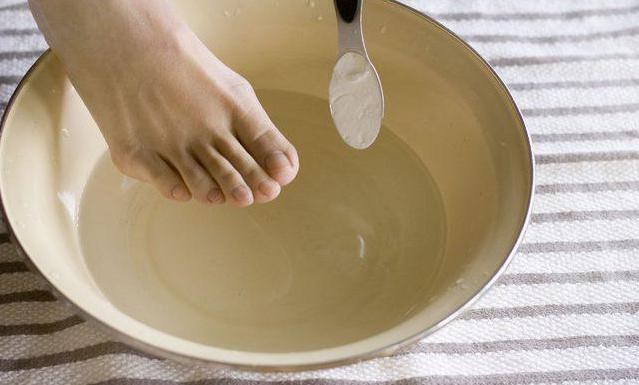
A bath with soda is done before removing dry calluses or corns on the feet. It is also present in almost all procedures for the treatment and removal of calluses at home.
For 1 liter of water at a temperature of about 40-45 degrees, take 1 tbsp. soda and a little soap. Dissolve the components in water and immerse your feet in water for half an hour. After steaming, your feet should be treated with pumice. It is recommended to do such baths every day for a week.
After the bath, apply compresses prepared according to folk recipes, for example, based on raw potatoes or bread crumbs. They will be discussed in detail below.
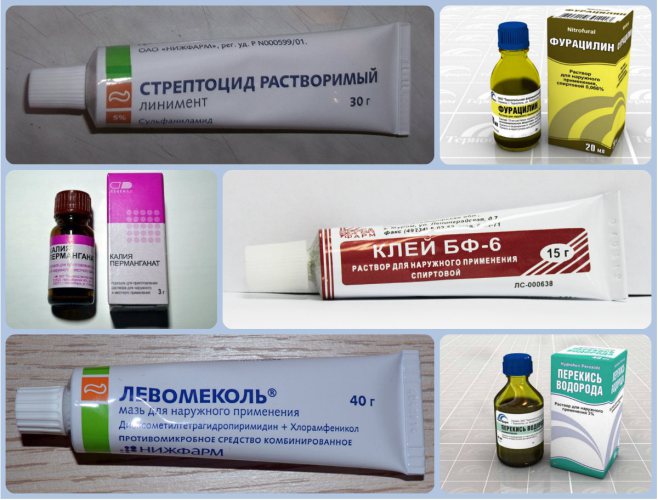
Calluses on the toe are caused by wearing uncomfortable shoes, especially pumps, because the pressure of the body's weight is placed directly on the toes. During treatment you should avoid wearing such shoes. A salicylic acid patch is an excellent remedy for calluses on the finger.
Sequence of callus treatment:
- First, the feet are steamed in a soap and soda bath.
- After steaming, a salicylic patch is glued to the damaged skin and worn for 2 days.
- After removing the patch, the callus will soften. All that remains is to clean it off with a pumice stone and lubricate the skin with moisturizer.
In this area, calluses can be either wet or dry formations, often of a core type. It is recommended to use a compress of anti-corn ointment.
- The callus area needs to be disinfected.
- Then they take a regular adhesive plaster, cut a hole in it so that the areas around the callus are covered with the plaster, and the callus itself remains open.
- Glue the patch in place.
- Apply ointment for calluses to the skin.
- A larger piece of adhesive tape is glued on top.
You should wear the compress for 1-2 days, after which the callus will soften so much that it will peel off on its own.
How to quickly cure flayed ones?
If the top layer of the callus is damaged, it is best to wash it with an antiseptic (peroxide or chlorhexidine, these agents cause the least burning sensation), and stick a patch containing acetylsalicylic acid on top. This is a component that has analgesic and anti-inflammatory effects.
What to apply to make it heal faster?
The most suitable remedies for rapid healing of calluses are:
- Salicylic ointment.
- Syntomycin emulsion.
- Levomekol.
- "Compeed" patch.
- Plaster "COSMOS Hydro Active" from HARTMANN PAUL.
Is it possible to apply iodine?
Yes, calluses can be smeared with iodine. It is better not to apply the solution to the skinned area.
The concentration of the product should be minimal to avoid potential burns to the skin, even if it is not damaged. To do this, iodine can be diluted with water in a 1:1 ratio. You need to apply it very carefully, as the product causes a strong burning sensation.
Is it possible to anoint with brilliant green?
Zelenka is less aggressive than iodine. There is no point in applying the product to dry calluses, because it dries out the skin even more.
It is best to use brilliant green to treat wet, unbroken calluses. This will ensure the prevention of secondary infection.
An exposed area of skin should not be lubricated with brilliant green, because, like iodine, it can cause a burn. The dilution ratio of the product with water is the same – 1:1.
How to treat an open one?
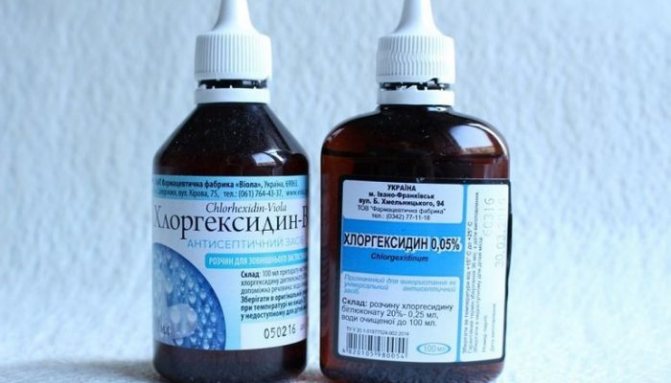
First of all, the open callus must be disinfected. Peroxide and chlorhexidine are suitable for this. It is better not to use alcohol, since its use may cause painful sensations on an already damaged area of skin.
You need to let the callus dry a little. Then it is sealed with a bactericidal plaster to speed up healing and prevent the entry of pathogenic bacteria.
Prevention
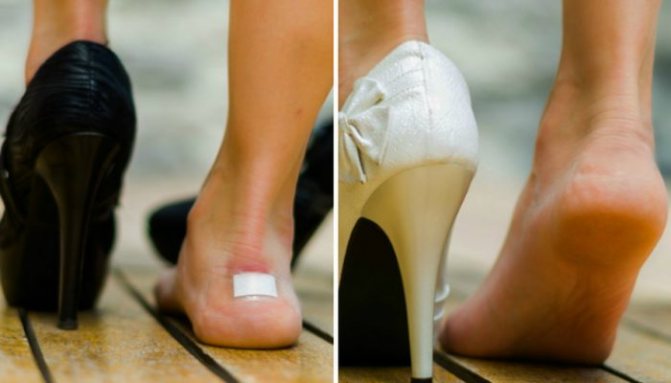
Prevention of calluses consists of the following rules:
- Selecting comfortable, breathable shoes of the appropriate size.
- Walk barefoot at home for at least an hour every day.
- Timely treatment of fungal infections of the feet.
- Complete rest for your feet.
- Elimination of hyperhidrosis.
- Maintaining optimal body weight.
- Proper hygienic foot care.
- Apply moisturizer to the soles of your feet daily.
Causes of calluses
In fact, it is a small area of dead skin that, through friction, acts on a new layer of epidermis.
Calluses are formed due to constant mechanical impact when wearing shoes or working with hand tools. The reason for their appearance is disruption of normal blood circulation in the local area of the skin and its death. There are the following types of epidermal disorders:
- Dry. As a result of friction of the old skin, the new layer is constantly irritated. Symptoms: Pain occurs when pressed.
- Wet. Formed under unstable pressure. The body's protective reaction - a fluid is produced that protects the new layer of the epidermis.
The best prevention of callus formation is the use of protective equipment. When wearing new shoes, a patch is applied to certain “risk areas”. During physical work, be sure to wear gloves. This will prevent friction and, as a result, normalize blood circulation.
Remedies for water blisters
If small water growths occur, it is strictly not recommended to open them.
You won’t be able to get rid of them quickly; it takes time for a new layer of skin to form. The site of irritation must be treated with special means, and the absence of stress on this area must be monitored. Before anointing the callus with medical compounds or using folk remedies, you should perform the following steps.
- Clean the damaged area of skin.
- For 5-10 minutes, immerse your foot in warm water with a small amount of soda, heated to +30°C. This will help soften the damaged area.
- If there is a large volume of water build-up, a puncture is performed and the released liquid is thoroughly washed off.
- Treatment with antiseptics.
- Applying a protective plaster.
If this remedy is not available at your home pharmacy, betadine, vocadine or ioddicerin can replace it. Similar products will also work. The main thing is that there are no contraindications, namely, an allergic reaction.
Medicines
The best treatment option is to treat the problem area with special compounds.
Despite the differences, they have one common effect - rapid healing of the skin and prevention of purulent processes. The most effective medications include the following:
- Salicylic ointment. The best option if the lesion is small or has appeared recently. The product has a drying effect, which is important for water build-ups. It can be used to treat a burst or small damaged area of the epidermis.
- Levomikol. The drug has anti-inflammatory and antibacterial properties. Promotes rapid healing of open wounds. First you need to burst the water build-up and apply a small layer of ointment. Then the damaged area is covered with an adhesive plaster.
- Compeed. A patch with a healing effect, the best option if you need to heal a small callus. After preliminary steaming and cleaning, it is glued to the problem area. Validity time is up to 24 hours.
- Zinc ointment. It is necessary for the healing of exposed areas of young skin. Calluses on the foot may be subject to constant stress from wearing shoes. Therefore, the formed wound will quickly heal after applying zinc ointment. The disadvantage is that it has a paste-like consistency and is recommended to be applied at night.
- Panthenol. It has the same effect as zinc ointment, but the healing process is faster.
It is recommended to perform self-puncture of dropsy no later than 24 hours after its appearance. The needle must be disinfected, the puncture site is treated with the means described above.
Treatment with traditional methods
In the absence of the medications described above, the question arises: how to treat the damaged area of the leg?
You can consider using folk remedies. But they are effective only for small water build-ups. The main requirement is rapid healing and disinfection of the callus. Based on the maximum expected effect, water callus can be cured using the following means:
- Aloe leaf. It is cut lengthwise and adjusted after pre-treatment of the wound. The best option for treating dry growths. Can be used for minor suppurations.
- Aspirin. They must be dissolved in water until a paste is obtained. It is recommended to add a small amount of lemon juice. The resulting composition should be spread on the damaged area and insulated with film. Action time – up to 25 minutes. Then pumice treatment and final cleaning are carried out.
- Soap and soda composition. The essence of the method is steaming. A small amount of soda, soap and a few drops of ammonia are added to warm water. Feet need to be steamed for up to 20 minutes.
Alternative methods include using lemon peel, potato peel or propolis. But they are not as effective as the methods described above.
The use of plantain is only relevant for the healing of an open wound that has formed. It can be used to heal a previously treated area of skin on the leg. But plantain does not have an anti-inflammatory effect.
How to treat calluses?
Firstly, wet calluses on the feet need to be treated properly, otherwise germs can get under the skin, which will make the healing process difficult.
Most blisters and calluses are filled with translucent fluid, but they can be filled with blood or pus if they become inflamed and infected.
➦ In order not to aggravate the situation with wet calluses, you should never burst the growth and allow the liquid to flow out, because then any sore can enter the bloodstream, which will cause a number of problems. The skin around the callus and specifically on the callus itself should be treated as often as possible with an antiseptic.
How to anoint and treat a callus
It takes a little longer to get rid of dry calluses.
➦ First you need to steam your feet in a bath so that the rough skin softens as much as possible. Afterwards, apply a thick emollient cream or salicylic ointment, hide everything under a bandage and leave the consistency on the callus site for 12 hours. It is important to create a greenhouse effect around the callus, because in this case, it will be easier to scrape it off.
Once softened, dry calluses can be removed with a blade or razor. You need to do everything carefully and carefully, because otherwise you can cut your leg and aggravate the situation.
If you have a problem with blisters and calluses, the following home remedies will help you get rid of this problem faster.
Aloe Vera
An excellent choice for combating blisters and calluses. This plant is replete with ingredients that produce anti-inflammatory effects and therefore reduce redness and inflammation. Additionally, due to the large amount of water it contains, aloe provides hydration to the problem area, which speeds up the healing process, especially if the callus has already ruptured.
✅ Apply fresh aloe vera to the callus and let it dry. Then rinse it with warm water. Another option is to combine aloe vera with the oil from one vitamin E capsule.
Black and green tea are considered anti-inflammatory, but green tea has a more intense anti-inflammatory effect. So if you have a choice, choose green tea.
✅ Place one bag of green tea in 250 ml of hot water and let it stand for 5 minutes. Then leave the tea at room temperature until it cools. Soak a piece of cotton in tea and place it on the callus for 15-30 minutes. Repeat this operation several times during the day.
Vitamin E
Vitamin E stimulates the healing process and prevents scarring.
✅ Take one vitamin E capsule and place the oil from the capsule on the callus. Let it sit for at least 30 minutes. Repeat the procedure every day.
Toothpaste
Thanks to the ingredients it contains, such as baking soda and menthol, toothpaste can help relieve painful blisters and calluses.
✅ Therefore, apply toothpaste to the affected area and let it stand for about 2 hours. Then remove it with warm water and apply foot cream. In this way, faster drying of the blisters is achieved and pain and itching are reduced.
Note: Do not use toothpaste intended for teeth whitening.
Chamomile
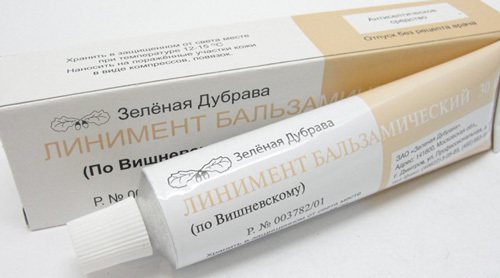
Thanks to the ingredients contained in chamomile tea, you can reduce the pain and swelling of the blisters.
✅ Make chamomile tea (two packs of tea per two hundred and fifty milliliters of water) and let it cool to room temperature. Take a piece of cotton and wash it with chamomile tea. Place the cotton on the callus for 10 minutes. Do this several times a day.
apple tree vinegar
Apple vinegar has an antibacterial effect, so if a callus ruptures, it can prevent an infection from starting. However, it should be noted that using apple cider vinegar may cause a slight burn and redness.
✅ Therefore, if you decide to use this natural remedy, then you should carefully apply a small amount of apple cider vinegar and carefully apply it to the problem area.
Turmeric
Turmeric is considered a natural antiseptic, so it can help relieve pain, reduce inflammation, and prevent infection.
✅ Mix one teaspoon of turmeric with a little water to get a homogeneous and thick mixture. Place the mixture on the problem area, let it sit for ten to fifteen minutes, and when finished, rinse with water. Perform the procedure three times during the day until the bubbles disappear.
!IMPORTANT: the surface of the callus or blister should not be removed. But if it's causing you a lot of pain, follow these tips:
- Wash your hands thoroughly;
- Take a clean and unused medical needle;
- Soak it with alcohol;
- Punch the callus on the side and let the liquid come out;
- Wash the area with soap and water;
- Place an antibiotic and protect the area with a bandage;
- Change the bandage every day.
Even if calluses on the feet do not bother a person, they must be treated. Feet without calluses are not only beautiful and well-groomed, but also healthy. It doesn’t matter which treatment method a person chooses, whether to remove calluses on their own or go to a clinic, the main thing is to start.
The article contains important recommendations on what you can anoint a callus on your foot to make it heal faster, and how to treat calluses on your feet from shoes at home. If a person has chosen home methods for getting rid of calluses, but the problem does not go away, you should immediately contact a medical facility, because the problem may be more serious than it seems at first glance.
Wet (water) calluses often appear on the soles of the feet, especially in the summer. Rubbing dropsy is quite simple: small pebbles or sand get into the gap between the skin and the shoes. As a result, a watery layer is formed between the layers of the epidermis, swollen with a bubble. You should not allow the dropsy to burst prematurely, since the “water” that fills it has bactericidal properties.
A burst callus can cause a lot of trouble due to the resulting pain and the possibility of inflammation, and then suppuration due to infection at the site where the integrity of the vesicle is broken. Quickly healing a burst callus means preventing the onset of the inflammatory process.
Suitable pharmaceutical products:
- patch for wet calluses, for example from Compeed. The patch acts as a “second skin”, has an analgesic effect, absorbs moisture, provides favorable conditions for the healing of the problem surface, protecting against moisture and dirt.
It can be worn for a long time, but only when necessary. The area of the burst bubble dries better in the open air. Antibacterial ointments. The most famous among them is Levomekol. It has a wide spectrum of action against many pathogenic microorganisms.
Levomekol is advisable to use when the wound is infected.
If the burst callus heals well, there is no need to smear it.
Traditional methods: Traditional medicine is an affordable and simple method of treating wet blisters.
Salty water. To treat calluses, you can use salt water rinses made from a liter of water and a tablespoon of table salt.
Rinse the foot with the solution and wipe dry with a cotton towel. Salt water dries the skin well and promotes rapid healing of the wound.
Aloe juice. Fresh indoor aloe juice has a wound-healing and drying effect. To treat calluses, use a compress made from a plant leaf, which is cut in half and applied to the sore spot.
To fix the aloe on top, you can wrap your leg with a sterile bandage. The compress can be worn for a long time, replacing the plant with a fresh one every 2-3 hours.
Baths with herbal decoctions. For baths, use a decoction of chamomile or calendula. The feet are completely immersed in the broth for 10-15 minutes. Procedures can be taken up to 4-6 times a day. The baths have an antiseptic and anti-inflammatory effect.
We suggest that you familiarize yourself with the sensation of a burn on the skin without external manifestations: Causes, Treatment
Wet callus is a very unpleasant phenomenon that causes not only physical discomfort, but also anxiety. This is due to the fact that a damaged bladder can become infected with bacteria - then infection cannot be avoided.
A wet or water callus is a kind of bubble filled with intercellular fluid. It is formed as a result of friction. Feet, ankles, and toes are injured as a result of wearing tight shoes, and hands are injured due to holding heavy objects and various tools. Excessive sweating also contributes to their formation. A characteristic feature of the defect is severe pain.
Initially there is redness and mild discomfort. If the friction continues, then a water callus forms and, if the negative impact is not stopped, it will burst.
Despite the fact that piercing such formations is highly discouraged, they cause inconvenience, so you want to get rid of them as quickly as possible. But violating their integrity significantly increases the risk of infection of the wound with bacteria and, accordingly, inflammation may develop on the toe or heel.
However, often damage cannot be avoided. In this case, you need to know what to do with an open wound. It is optimal to be able to open large bubbles that require a puncture.
Knowing simple rules, you can prevent serious negative consequences and significantly reduce the recovery time of your skin.
Is it possible to pop a bladder yourself? Yes, you can. But only if it is large. It and the needle are treated with any antiseptic at hand. When making a puncture, try to keep the needle parallel to the surface of the skin. Subsequently, the same manipulations are carried out as with an open wound.
How to treat the callus further? To quickly get rid of a defect, you need to adhere to one rule - always disinfect. If you ignore this measure, then microbes can enter the open wound, resulting in an inflammatory process. The latter can quickly spread to healthy tissue. If the leg is swollen, then this is exactly what happened.
Treatment of hard calluses
Hard growths with roots going deep into the skin are the most difficult to treat.
For self-removal, it is not enough to simply smear the area with cream or apply a band-aid. It is necessary to get rid of the root, which can cause severe pain when walking. Professional removal occurs using laser or cryotherapy. In the latter case, the damaged area is exposed to liquid nitrogen, and then the root is removed. Self-treatment is recommended only for new formations. In this case, you can apply the methods described above. If the damage is large, professional medical attention is needed.
Recommendations for getting rid of calluses with roots on the leg:
- Constantly make soap and soda baths. The expected effect is a softening of the outer layer.
- Do not try to cut off the damaged skin and remove the root yourself. With proper treatment, it should fall out on its own.
- Minimize the load on the painful area of the foot.
Treatment of calluses with a rod
Many people want to know how to quickly cure a callus on the heel. If there is a rod inside the defect, it is better to contact a specialist. The doctor will tell you what to do in such a situation. The cause of this pathology is often the entry of a foreign body or virus into a normal callus. Dermatologists offer to eliminate defects with the rod in a hospital setting. There are several methods.
- Laser coagulation. The beam, due to exposure to high temperatures, burns out the damaged space deep in the epidermis. The surrounding tissues are not damaged. This is a modern, painless procedure. Heel callus is eliminated quickly, and the skin is easily restored after the intervention.
- Drilling. The doctor uses cutters of a certain size. The tool is selected individually, based on the diameter of the callus. Antiviral agents must be injected into the resulting wound.
- Cryodestruction. The technique involves getting rid of calluses on the heels using liquid nitrogen. Changed cells are destroyed by exposure to cold.
All of the above methods are safe and effective. Patients are interested in how to cure calluses with a core at home. The procedure is carried out in several stages. First, your feet need to be steamed in a hot bath. It is useful to add soap shavings mixed with soda to the water. Within half an hour, the skin of the feet softens.
Causes of calluses
What is a callus? This is a dead area of skin that acts on a new, growing layer of the epidermis through friction. These growths are formed under constant mechanical influence.
The most basic cause of calluses is a disruption of blood circulation in a certain area of the skin, and the death of this area of the dermis.
There are two types of these neoplasms:
- dry, resulting from the constant mechanical impact of the old dead skin area on the new one (causes pain when pressed);
- wet, formed due to constant exposure, as a protective reaction, fluid is produced that protects the new layer of the epidermis.
It is important to choose the right drug, as some drugs may simply be ineffective.
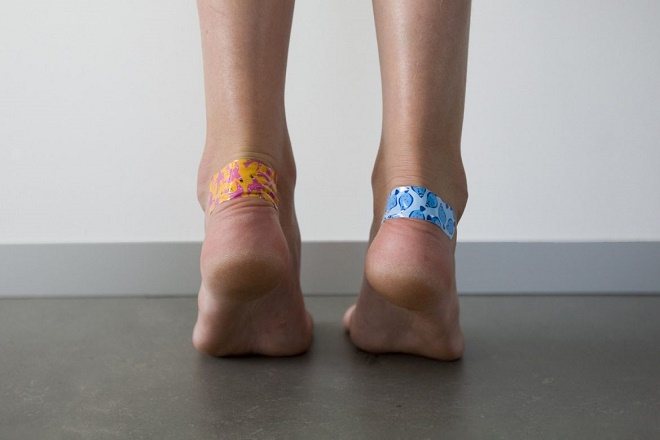
How to get rid of a callus on your foot?
It is strictly not recommended to open watery growths, since in any case it is unlikely that you will be able to quickly get rid of them. For a callus to heal, it simply takes time for a new layer of epidermis to form.
It is important to constantly treat the affected area with special means to ensure minimal mechanical impact.
Before anointing the growth with any preparation, it is recommended to carry out the following procedure:
- clean the damaged area of skin;
- make a foot bath by immersing your feet in warm water and baking soda to soften the damaged area;
- if the watery growth is very large, then it is necessary to puncture it with a needle, first sterilize it, and thoroughly rinse off the secreted liquid;
- treat the area with an antiseptic;
- If necessary, cover with a protective plaster.
To prevent the occurrence and development of infection, the treated callus can be smeared with iodine. This will help reduce the risk of a purulent abscess.
Should I pierce the callus myself?
If the water blister is large and prevents you from wearing shoes, you can help it break by piercing it yourself. Don't wait for the callus to burst at the wrong time and place. In this case, education can heal faster.
Before the procedure you need to prepare:
- Wash your hands thoroughly and treat them with alcohol;
- A needle (sewing pin, pin, syringe) must be calcined over an open fire (burning match, lighter, gas burner) or disinfected by dipping it in alcohol or iodine for 1-3 minutes;
- Treat the area around the callus on the foot, washing with warm water and laundry soap.
It is recommended to hold the needle parallel to the surface of the leg when piercing the callus. You need to make 2 holes through which to squeeze out the liquid that filled the blister and immediately treat the surgical site with an antiseptic. The product is applied with blotting movements, without removing the skin covering the wound. It is recommended to seal the callus with a bactericidal plaster; you can also use a callus plaster.
We invite you to familiarize yourself with a birthday gift for dad from children
Medicines for calluses
In order for the callus to heal faster, it must be anointed with a special product. Today, there are many pharmacological drugs for calluses, which have the main effect of rapid healing and prevention of the development of purulent processes.

List of the most effective and popular drugs for calluses:
- Salicylic paste is a cheap and effective, universal drug that will help get rid of a callus if it has recently appeared. The ointment has a drying effect, so it easily fights watery growths. You can also use salicylic-zinc paste, which has an even better effect. Zinc ointment has the same properties.
- Levomekol - ointment has an anti-inflammatory and antibacterial effect, providing a rapid healing effect. It is necessary to apply the ointment to the burst callus and seal it with a band-aid, repeating this procedure as often as possible.
- Compeed is a special patch for calluses that has a healing effect. After carrying out hygienic procedures, the patch must be glued to the area with the callus. After 24 hours, if necessary, replace the patch with a new one.
- Panthenol - has a healing effect.
- Levomycetin is a local antibacterial drug. Already on the second day after starting to use the ointment, the suppuration on the callus is eliminated. Effective for both dry and wet calluses. The action of the ointment is similar to Levomekol.
- Vishnevsky ointment - this drug has been used in the field of medicine for many years and is a universal local remedy. Can be used for both types of calluses. It has an excellent composition: birch tar, Xeroform powder and castor oil.
- Ichthyol ointment is a universal drug with anti-inflammatory and antiseptic effects. Perfectly softens and disinfects calluses and damaged skin. The effect is similar to Vishnevsky ointment.
You can also use topical callus creams. For example, Namozol-911, Callus healer, Sophia cream, Mozol cream and so on.
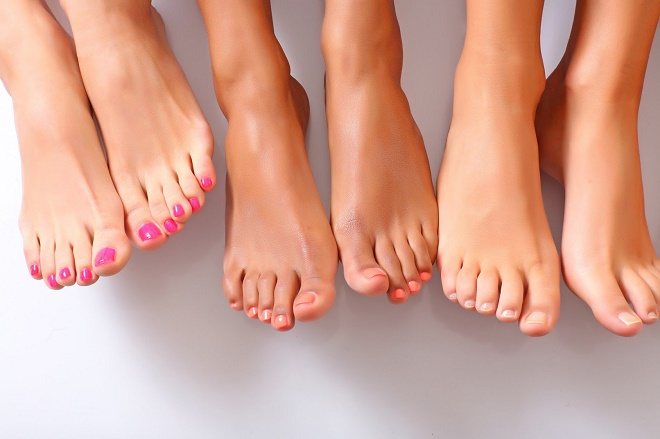
Treatment of complications
The biggest problem is treating the child. Delicate skin often wears off into blood and turns into purulent inflammation. Despite the painfulness of the procedure, both dry and wet calluses must be treated with iodine. This product perfectly disinfects, dries and prevents the occurrence of purulent inflammation.
Particular attention should be paid to the healing of open wounds that show signs of purulent inflammation. For a long time in Rus', such problems were easily solved with the help of tar. It disinfects well, relieves swelling and restores tissue.
Once the famous Russian military surgeon A.V. Vishnevsky treated numerous wounds with tar. Subsequently, he created an ointment, which became known as Vishnevsky’s ointment. It included:
- birch tar;
- xeroform powder;
- Castor oil.
This ointment is now sold mainly under the name “Balsamic Liniment”.
The combination of ingredients helps the antiseptic components penetrate deep into the skin, thereby stimulating blood flow to damaged tissues and softening rough skin. The only unpleasant thing is the smell of liniment.
If for some reason you don’t like Vishnevsky’s ointment, and the wet callus has rubbed off until it bleeds, then you can follow the next path. Spread something gel-like on the cotton wool. It is better, of course, to use something medicinal, but ordinary Vaseline will do. Sprinkle penicillin powder on it, apply it to the wound, wrap it with a bandage and leave for several hours.
READ MORE: Callus formation during a spinal fracture
From folk remedies you can use aloe leaf and lemon. Cut off the top of the lemon, place it on the callus and secure with a bandage or plaster. You can also use aloe leaf.
Honeysuckle leaves have good bactericidal properties. It is best to make a powder from dry leaves and apply it to the callus instead of penicillin. However, you can also use steamed fresh leaves.
The described means and methods of dealing with calluses do not pretend to be a complete review. However, this is quite enough to cope with such traumatic skin problems.
Traditional recipes for calluses
You can also use folk recipes for calluses, which, in combination with medications, will help you quickly get rid of this problem.
Water callus can be cured using the following alternative medicine methods:
- aloe - a compress is applied to the affected area, perfect for dry growths, can be used for suppuration;
- aspirin - mix aspirin dissolved in water with a small amount of lemon juice, apply to the area with the callus, wrap it with film, after half an hour treat the area with pumice;
- soap-soda solution - you need to steam your feet in this solution (warm water, grated soap, soda) and clean the dead areas with a pumice stone or a heel file.
It takes time to completely get rid of calluses. Therefore, do not rush to cut off the growths, as this will lead to their reappearance. If traditional methods and the use of proven drugs do not help, be sure to consult a doctor.
How to quickly get rid of calluses at home
Treating water (wet) callus on the heel
Water calluses appear in the heel area or near the Achilles tendon. If the capillaries are affected, the callus will be bloody. Most often, a wet callus occurs as a result of friction and wearing tight shoes.
To get rid of a callus on your heel, follow these steps:
- Wash your foot carefully so that the callus does not burst.
- Apply a special patch for wet calluses.
- Make a pillow from sterile gauze pads.
- Apply to the bubble and secure with a regular band-aid.
- Change the bandage 2 times a day, morning and evening.
- Do not puncture the callus, otherwise there will be a risk of infection.
- If the callus bursts on its own, do not touch the pieces of skin: they serve as protection.
- Wash the callus with chlorhexidine and change the gauze bandage regularly.
- If suppuration occurs, consult a doctor immediately.
Getting rid of dry calluses
A dry callus looks like a small yellowish bump on the skin; it doesn’t hurt much. It occurs from wearing uncomfortable shoes and can develop into a water callus if proper measures are not taken.
Removing dry callus:
- Dilute a bath with warm water, sea salt and soda before going to bed. For 3 liters of water, 1 tablespoon of salt and the same amount of soda.
- Steam your feet for 10-15 minutes, then wipe dry with paper napkins and scrape the callus with a cotton pad or a wooden stick.
- Lubricate the area of damaged skin with zinc paste and try to exfoliate the dead skin. If the callus does come off, leaving a pink mark, then use a rich baby cream. After the procedure, blot off excess cream with napkins and put on socks. If necessary, repeat the procedure after 3-4 days.

How to cure callus
Calluses most often form on the toes. Outwardly, it resembles a dry callus, but has a hole in the middle and affects much deeper layers of the epidermis. Occurs from wearing tight shoes. At home, you can get rid of such calluses using a patch with salicylic acid, which is sold at the pharmacy. It is recommended to wear this patch for 1-2 days and reapply if necessary. You should not try to open the callus yourself, this is fraught with complications.
How to get rid of calluses on your toes
Calluses on the toes are not easy to treat due to constant friction against the inner edge of the shoe. The fastest way to get rid of calluses on your fingers is to walk barefoot or wear open shoes. In other cases, you will have to intervene with the use of pharmaceuticals.
How to get rid of a callus on the little toe
These calluses look like hardened blisters on the very phalanx of the finger. You can get rid of calluses on the little finger using a protective pad of gauze and cotton wool. You need to rinse your finger with warm water, wipe it with a cotton pad with chlorhexidine and lubricate the area with callus ointment, which is sold in any pharmacy. Attach a pad of gauze and cotton wool to the surface of the damaged area using a bactericidal patch. It is important to isolate the rubbed little finger from its healthy counterparts to ensure quick and comfortable healing.
How to get rid of dry calluses on the soles
Calluses on the soles occur due to tight shoes or thin insoles that do not absorb the step, causing the foot to hit the asphalt with special force. Depending on the type of callus (dry or water), treat the sole using the appropriate method described earlier, wrap it tightly with a bandage around it or secure a wide piece of bactericidal plaster over the entire surface of the damaged area.
How to get rid of corns on the feet
Corns occur due to the greatest pressure on an area of skin. They most often appear on the heels, between the toes and on the foot under the toes. The formation of corns is usually associated with flat feet and wearing high-heeled shoes.
- Soak your feet in hot water with sea salt and remove the layer of dead skin with a washcloth and pumice stone.
- The pharmacy sells products for effective foot peeling, which are based on urea, which is necessary to soften skin deformations.
- Use special plasters specifically for the foot area and cotton wool and gauze pads to reduce pressure on the affected area of the skin.
How to get rid of a callus on your foot
Hard shoe bridges can damage the top or side of the foot, where the skin is much more delicate. In this case, it is necessary to treat the callus in a more delicate way. Unlike the rough skin of the sole or toes, the top of the foot is much more sensitive. You need to rinse your leg with warm water, clean the wound with hydrogen peroxide and lubricate it with Levomekol or Rescuer ointment. Cover the wound with a piece of gauze and secure it with a thin layer of bandage or a strip of bactericidal plaster. Change the bandage 2 times a day until complete healing.
Photo: Getty Images
How to brush your teeth correctly: the secrets of a beautiful smile

